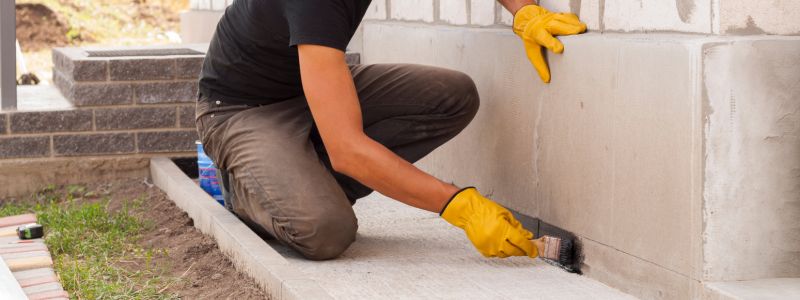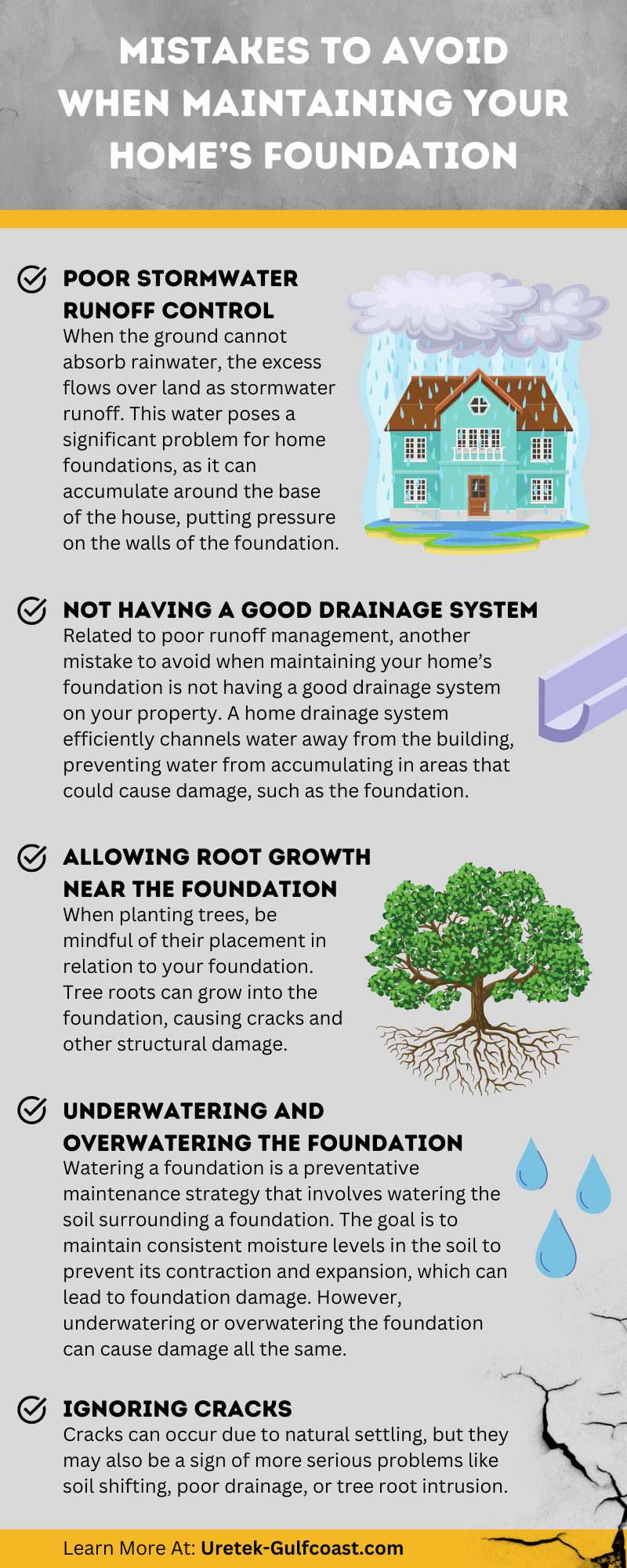The foundation of your home bears the entire weight of your structure, playing a vital role in maintaining its stability and longevity. However, many homeowners often overlook the importance of regular foundation maintenance, not noticing foundation damage until it causes the house infrastructure to warp or develop cracks.
Ignoring maintenance can lead to severe problems like structural instability, water damage, and other costly repairs. Learn six mistakes to avoid when maintaining your home’s foundation to safeguard your home.
1. Poor Stormwater Runoff Control
When the ground cannot absorb rainwater, the excess flows over land as stormwater runoff. This water poses a significant problem for home foundations, as it can accumulate around the foundation..
Besides placing pressure on the concrete slab, stormwater runoff can also cause soil erosion around the home. Soil erosion undermines a home’s foundation by washing away the supportive soil around it, which can lead to uneven settling and potentially cause cracks and serious structural damage.
Landscaping Helps Manage Stormwater Runoff
Homeowners have several strategies at their disposal to manage runoff from their rooftops. \ Gutters and a drain system the directs rain away from the home is important for every home. Vegetation can improve water absorption and mitigate erosion. Likewise, rain gardens and swales are other landscaping methods for controlling runoff.
2. Not Having a Good Drainage System
Related to poor runoff management, another mistake to avoid when maintaining your home’s foundation is not having a good drainage system on your property. A home drainage system efficiently channels water away from the building, preventing water from accumulating in areas that could cause damage, such as the foundation.
A typical home drainage system consists of several essential components. Gutters and downspouts collect rainwater from the roof and direct it away from the foundation. Additionally, the system includes catch basins and grates to collect surface water. Subterranean pipes, often constructed from PVC, then carry this water to a safe discharge point away from the property.
Tips for Maintaining Your Drainage System
To ensure your drainage system works correctly, keep it free of debris and blockages. Regularly cleaning gutters, downspouts, catch basins, and grates will remove any buildup that could impede water flow. Additionally, periodically inspect your system and repair or replace damaged parts.
3. Allowing Root Growth Near the Foundation
When planting trees, be mindful of their placement in relation to your foundation. Tree roots can grow into the foundation, causing cracks and other structural damage.
You should plant trees with invasive root systems far enough away so that their roots do not come into contact with the foundation. If a tree is already too close, consider having it removed or installing a root barrier to protect your foundation from damage.
While tree roots are the biggest vegetative culprit of foundation damage, other plants can pose a similar risk. When landscaping around your home, leave a gap between all plants and the foundation. This will allow for proper airflow and reduce the chance of roots penetrating the foundation.
4. Underwatering and Overwatering the Foundation
Watering a foundation is a preventative maintenance strategy that involves watering the soil surrounding a foundation. The goal is to maintain consistent moisture levels in the soil to prevent its contraction and expansion, which can lead to foundation damage. However, underwatering or overwatering the foundation can cause damage all the same.
One popular foundation watering method is to use soaker hoses, which are hoses with small holes that allow water to seep out slowly into the soil. You can place these around the perimeter of your home. Alternatively, you can install a drip irrigation system around your home’s perimeter.
Please note: Watering your foundation properly is tricky and not necessarily recommended by URETEK. For the purpose of this post, we felt it important to include it.
5. Ignoring Cracks
Ignoring cracks on your home’s interior and exterior walls is another critical mistake that homeowners make. Cracks can occur due to natural settling, but they may also be a sign of more serious problems like soil shifting, poor drainage, or tree root intrusion.
Cracks caused by a shifting foundation can appear in several areas throughout your home. Hairline openings are often due to natural settling, while larger, horizontal ones can signal serious foundation shifting. Interior signs can include cracks on walls, especially over doorways or windows or where walls meet ceilings. These rifts can also appear in the flooring, with tiles or wooden planks showing signs of stress or breakage.
Cracks on the external walls of your home, particularly on bricks, can also signal foundation problems. These splits form when the foundation shifts or settles unevenly. Often, these are stair-step cracks that follow the mortar joints in a brick or block wall. Over time, water can seep into these fissures and lead to more extensive damage due to freeze-thaw cycles.
What To Do if You Notice Cracks
If you notice cracks in your home’s foundation, don’t ignore them. Start by documenting the crevices, noting their size and location and monitoring them over time to see if they are growing.
You can seal small cracks with waterproofing sealant as a preventative measure, but you should call a professional for more serious issues, such as large, growing cracks or fissures in concerning places. A structural engineer or foundation repair specialist can assess the situation and recommend a course of action to prevent further damage to your home.
6. Delaying Plumbing Repairs
Water damage to the foundation doesn’t come only in the form of rain. Ignoring plumbing issues can wreak havoc on your home’s foundation. Leaky pipes can saturate the soil around your foundation, causing it to expand and putting pressure on the foundation walls, which can lead to cracks and structural instability. On the other hand, severe plumbing issues, like broken sewer lines, can cause significant soil erosion beneath the foundation, leading to foundation settling, uneven floors, and potentially catastrophic structural damage.
The longer you wait to fix plumbing problems, the more damage can occur to your plumbing system and home’s foundation. Don’t hesitate to contact a licensed and insured plumber to prevent potential damage to your home’s foundation.
Protect your property by choosing experienced plumbing and foundation professionals. URETEK ICR Gulf Coast is a leading plumbing company in Houston, offering free estimates and financing for homeowners. Call us today to protect your home’s foundation with effective plumbing solutions!


